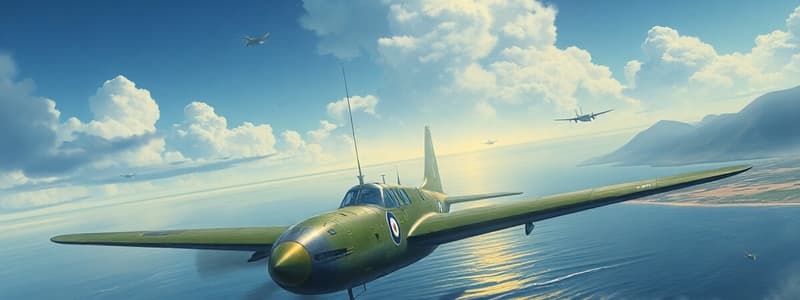Podcast
Questions and Answers
Which of the following statements accurately defines the primary objective of Operation Shō-Shō?
Which of the following statements accurately defines the primary objective of Operation Shō-Shō?
- To launch a coordinated, multi-pronged attack on the US fleet in the Pacific, aimed at securing the Leyte Gulf for Japan.
- To decisively cripple the Allied fleet in the central Philippines' Leyte Gulf, disrupting their impending landings. (correct)
- To regain control of the Philippines, strategically positioning Japan for a counteroffensive in the Pacific Theater.
- To secure the Leyte Gulf area for Japan, ensuring the safe passage of Japanese military resources and reinforcements.
Which of the following accurately represents the composition of the First Mobile Fleet's Main Body, known as the 'Northern Force'?
Which of the following accurately represents the composition of the First Mobile Fleet's Main Body, known as the 'Northern Force'?
- The Kure-based carrier force, accompanied by a contingent of battleships and cruisers for protection. (correct)
- A formidable force of battleships, cruisers, and aircraft carriers, with a substantial contingent of destroyers and submarines.
- The majority of Japan's remaining battleships, cruisers, and carriers, with significant support from land-based aviation.
- A combined force of battleships, cruisers, and carrier groups drawn from various Japanese naval bases.
What tactical maneuver did the Japanese Northern Force successfully execute in the Battle of Leyte Gulf?
What tactical maneuver did the Japanese Northern Force successfully execute in the Battle of Leyte Gulf?
- A coordinated attack on the allied fleet, involving aerial, naval, and submarine operations.
- A strategic withdrawal, effectively drawing away the US Third Fleet from the Leyte Gulf area. (correct)
- A desperate last stand, engaging the US Third Fleet in a fierce but ultimately unsuccessful battle.
- A surprise flanking maneuver on the Allied fleet, exploiting a weakness in their defense.
What was the ultimate fate of the First Mobile Fleet's Northern Group?
What was the ultimate fate of the First Mobile Fleet's Northern Group?
The First Mobile Fleet's Third Section, approaching the Philippines from the southwest, was combined with which other force to form the 'Southern Force'?
The First Mobile Fleet's Third Section, approaching the Philippines from the southwest, was combined with which other force to form the 'Southern Force'?
Which of following statements describes the outcome of the Battle of Surigao Strait for the Southern Force?
Which of following statements describes the outcome of the Battle of Surigao Strait for the Southern Force?
What tactical advantage did the US Seventh Fleet possess in the Battle of Surigao Strait that contributed to their victory?
What tactical advantage did the US Seventh Fleet possess in the Battle of Surigao Strait that contributed to their victory?
What actions did the Brunei-based First Diversion Attack Force face on October 23rd and 24th, respectively?
What actions did the Brunei-based First Diversion Attack Force face on October 23rd and 24th, respectively?
What was a significant factor contributing to the limited effectiveness of the Japanese carrier air groups in Operation Shō-Shō?
What was a significant factor contributing to the limited effectiveness of the Japanese carrier air groups in Operation Shō-Shō?
Which of the following accurately reflects the significance of the Battle of Leyte Gulf for the Japanese Imperial Navy?
Which of the following accurately reflects the significance of the Battle of Leyte Gulf for the Japanese Imperial Navy?
What was the primary objective of the Japanese force that broke out of the San Bernardino Strait?
What was the primary objective of the Japanese force that broke out of the San Bernardino Strait?
What was the significance of the Northern Force's successful decoy of the U.S. Third Fleet?
What was the significance of the Northern Force's successful decoy of the U.S. Third Fleet?
Why is the Battle off Samar considered the most dramatic naval engagement of the Leyte campaign?
Why is the Battle off Samar considered the most dramatic naval engagement of the Leyte campaign?
What was the ultimate outcome of Operation Shō?
What was the ultimate outcome of Operation Shō?
How did the Leyte campaign affect the strategic threat posed by the Imperial Japanese Navy?
How did the Leyte campaign affect the strategic threat posed by the Imperial Japanese Navy?
Which of the following BEST characterizes the U.S. Seventh Fleet escort carrier task units that engaged the Japanese Center Force?
Which of the following BEST characterizes the U.S. Seventh Fleet escort carrier task units that engaged the Japanese Center Force?
Based on the context, identify the most probable meaning of the phrase "amphibious shipping" as used?
Based on the context, identify the most probable meaning of the phrase "amphibious shipping" as used?
What does the use of the term "repulsed" suggest regarding the outcome of Operation Shō?
What does the use of the term "repulsed" suggest regarding the outcome of Operation Shō?
Which of these aspects was most significant in the context of the Leyte Gulf battle according to the text?
Which of these aspects was most significant in the context of the Leyte Gulf battle according to the text?
What does the term "unabated" suggest about the American offensive in the Philippines?
What does the term "unabated" suggest about the American offensive in the Philippines?
Flashcards
San Bernardino Strait
San Bernardino Strait
A strait in the Philippines crucial for naval passage during WWII.
Battle off Samar
Battle off Samar
A significant naval engagement where U.S. forces faced a larger Japanese fleet on October 25, 1944.
Leyte Gulf
Leyte Gulf
Site of major World War II battles where U.S. forces aimed to retake the Philippines.
Operation Shō
Operation Shō
Signup and view all the flashcards
U.S. Third Fleet
U.S. Third Fleet
Signup and view all the flashcards
Japanese withdrawal
Japanese withdrawal
Signup and view all the flashcards
Escort carrier task units
Escort carrier task units
Signup and view all the flashcards
American offensive in the Philippines
American offensive in the Philippines
Signup and view all the flashcards
Imperial Japanese Navy
Imperial Japanese Navy
Signup and view all the flashcards
Close air support
Close air support
Signup and view all the flashcards
Battle of Leyte Gulf
Battle of Leyte Gulf
Signup and view all the flashcards
First Mobile Fleet
First Mobile Fleet
Signup and view all the flashcards
Admiral William F. Halsey
Admiral William F. Halsey
Signup and view all the flashcards
Battle of Cape Engaño
Battle of Cape Engaño
Signup and view all the flashcards
Southern Force
Southern Force
Signup and view all the flashcards
Battle of Surigao Strait
Battle of Surigao Strait
Signup and view all the flashcards
Center Force
Center Force
Signup and view all the flashcards
Leyte Gulf invasion force
Leyte Gulf invasion force
Signup and view all the flashcards
Multi-pronged attack
Multi-pronged attack
Signup and view all the flashcards
Study Notes
Operation Shō and the Battle of Leyte Gulf
-
Japanese Strategy: Operation Shō, a desperate Japanese attempt to halt Allied landings in the Philippines, involved a multi-pronged attack utilizing most of Japan's remaining naval forces (battleships, cruisers, carriers). Land-based aviation units in Formosa and the Philippines were to support the carrier air groups.
-
First Mobile Fleet's Main Body (Northern Force): This force, based in Kure, Japan, drew Admiral Halsey's Third Fleet away from Leyte Gulf. The Northern Force was largely destroyed in the Battle of Cape Engaño on October 24th.
-
First Mobile Fleet's Third Section (Southern Force): This force, combining the Brunei-based section and the Kure-based Second Diversion Attack Force, was defeated by the U.S. Seventh Fleet's bombardment and fire-support group (Battleships, cruisers, destroyers, PT boats) in the Battle of Surigao Strait on October 24/25. This battle was notable for a U.S. force successfully crossing the "T" of a Japanese force.
-
First Diversion Attack Force (Center Force): Based in Brunei, this force was weakened by U.S. submarines and air attacks. Despite this, it sought to destroy Allied amphibious shipping in Leyte Gulf. Facing only three U.S. Seventh Fleet escort carrier task units after the Northern Force's successful decoy, this force engaged in the Battle off Samar on October 25th. The badly outnumbered escort carriers fought fiercely but were eventually forced to withdraw.
-
Outcome of Operation Shō: Operation Shō was decisively repulsed by October 26th. The battle severely damaged the Imperial Japanese Navy, eliminating it as a significant strategic threat. The American offensive in the Philippines continued unabated.
Studying That Suits You
Use AI to generate personalized quizzes and flashcards to suit your learning preferences.




